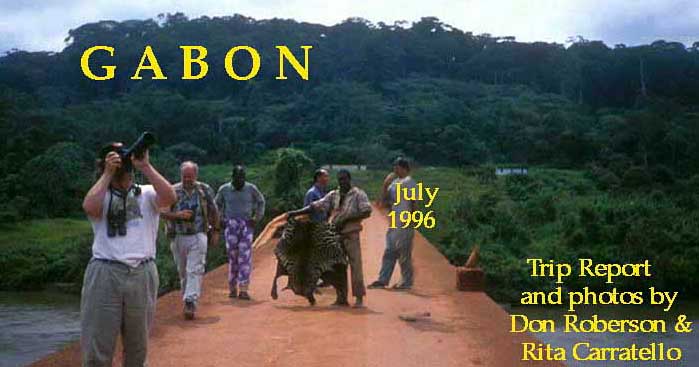

This is an account of a bird trip to Gabon in July 1996. As long as I have looked at geophysical maps of the African continent, I had wanted to visit Gabon. Here was an entire country shaded in dark green, meaning it was entirely tropical lowland forest! As my interest in travel and world birding grew in the 1980s, I learned that Gabon still had one of the highest percentages of forest cover left in the world, with over 90% pristine jungle still intact.
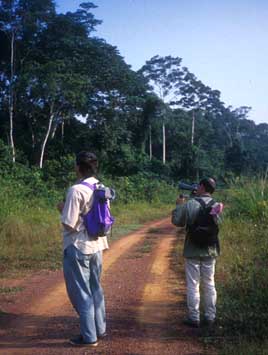 To
visit Gabon, Rita Carratello and I joined a tour led by Ian Sinclair (lefthand
in the photo at right) and Patrice Christy (righthand in photo). Gabon
was once part of French colonial Africa and therefore a working knowledge
of French is essential for travel. Although Rita and I have enjoyed traveling
the English speaking world on our own, and can get around Latin America
on Rita's Spanish ability, this was the type of country we felt safer in
doing a tour. The trip was initially meant to be a tour whose participants
were hand-picked by our friend the late Arnold Small, but various difficulties
undermined that initial plan. Arnold himself took ill and was unable to
make the trip and in the end no close friends were included. Rita and I
were not well matched with those who made the tour, and group dynamics
were poor. More than any other trip, this one highlighted for us why we
avoid professional bird tours whenever possible.
To
visit Gabon, Rita Carratello and I joined a tour led by Ian Sinclair (lefthand
in the photo at right) and Patrice Christy (righthand in photo). Gabon
was once part of French colonial Africa and therefore a working knowledge
of French is essential for travel. Although Rita and I have enjoyed traveling
the English speaking world on our own, and can get around Latin America
on Rita's Spanish ability, this was the type of country we felt safer in
doing a tour. The trip was initially meant to be a tour whose participants
were hand-picked by our friend the late Arnold Small, but various difficulties
undermined that initial plan. Arnold himself took ill and was unable to
make the trip and in the end no close friends were included. Rita and I
were not well matched with those who made the tour, and group dynamics
were poor. More than any other trip, this one highlighted for us why we
avoid professional bird tours whenever possible.
The saving graces of the trip were (a) fabulous habitat, (b) wonderful experiences with some of the best forest birds that can be encountered, and (c) Patrice Christy. Patrice, a French citizen living in Gabon, is the premier birder of Gabon. His field guide to La Lopé Reserve (in French but with nice color plates) had just come out and was excellent. He knew his country and its birds extremely well. Ian Sinclair, from South Africa but widely traveled, was also very good with the birds of Gabon, but Patrice was superb. Better yet, Patrice was a great person with whom to travel and bird. Unlike many professional leaders, he treated us as peers: good birders in our own country but as enthusiastic novices in central Africa. Patrice's English was not fluent but we nonetheless had some fine conversations about such concepts just as vagrancy in birds, methodology of documenting rarities, taxonomy and its various approaches, and lots about the vocalizations of birds in Gabon. He taught us a lot.
In contrast with other members of the tour group, I had studied extensively
for the trip. I was not just "ticking off" birds found by the leaders.
Yes, it was great to have the expertise of Patrice and Ian, but I wanted
to learn the birds myself. There was no field guide to Gabon or Central
Africa in 1996 (and there is still no such guide as I write this in 2001).
Thus I had prepared my own homemade "field guide" of species not shown
in either the very outdated Serle & Morel (1977) Birds of West Africa,
or widespread African species illustrated in Sinclair et al. (1993) Illustrated
Field Guide to Birds of Southern Africa.
 I did this by photographing various plates from the Birds of Africa
(Keith et al. 1992, and other volumes in the series; it was completed through
bulbuls & babblers at the time) and physically cutting & pasted
them into a blank field-guide size book; xeroxing selected pages specialty
books (e.g., Swifts); copying & reducing the i.d. keys in Sargeant
(1993) and pasting them into my book; and drawing my own color pencil sketches
of other species by using the descriptions from Mackworth-Praed & Grant
(1970-1973; a page from my homemade guide is at right). In the end
I had a pocket-sized guide with lots of information about Central African
species, and it proved quite useful.
I did this by photographing various plates from the Birds of Africa
(Keith et al. 1992, and other volumes in the series; it was completed through
bulbuls & babblers at the time) and physically cutting & pasted
them into a blank field-guide size book; xeroxing selected pages specialty
books (e.g., Swifts); copying & reducing the i.d. keys in Sargeant
(1993) and pasting them into my book; and drawing my own color pencil sketches
of other species by using the descriptions from Mackworth-Praed & Grant
(1970-1973; a page from my homemade guide is at right). In the end
I had a pocket-sized guide with lots of information about Central African
species, and it proved quite useful.
The 100 page xeroxed A Birder's Guide to Gabon (1993) by Dave Sargeant was excellent. It is actually an extensive privately published report on Sargeant's own visits to Gabon between 1988-1992 but contained detailed site guides, an annotated list of Sargeant's observations which help one learn status & distribution, and lots of identification material. The latter were particularly helpful for greenbuls, sunbirds, and batises. We acquired Christy & Clarke (1994) Guide des Oiseaux de la Réserve de la Lopé from Patrice in Gabon, so we did not get to study it ahead of time. I found it a very fine field guide even though my ability to read it was limited to some long-ago high school French.
Gabon is a very underbirded country, and one can still make significant discoveries. New distributional records are almost expected anytime a birder goes to southeastern Gabon where few have been. Sargeant's booklet really emphasized that area, but he had never been to La Lopé which turned out to be incredible. In pre-trip literature, Ian had summarized the trip this way:
"We will visit a vast and newly created reserve in central Gabon, La Lopé, which holds not only the highest population of primates in the world but with its multiple habitats has an astonishing list of bird species. Although we will spend much time in the jungle, an area in the south, on the border near the Congo Highlands, holds many grassland species in a mixed Miombo woodland and heathland habitat characterized by unusual stunted protea-like scrub. Here near Franceville we will wander over the plains in search of Congo Moorchat, try to flush a Finsch's Francolin, and watch Denham's and White-bellied Bustards striding across the veldt. In a slightly more hilly region in the north, we will wend our way through swamp and riverine forest to a set of caves harboring thousands of bats. It is here that we should also find that avian enigma of west Africa, the Red-headed (Gray-necked) Rockfowl, while overhead we might hear the thrumming of the Lyre-tailed Honeyguide's display flight. By the time we finally return to Libreville, we will have seen a superb selection of central and west African birds in one of the few countries in the region where pristine wilderness is not just a memory."We did follow this proposal: a big loop around Gabon. We did not see Finsch's Francolin or Denham's Bustard, but all the other species mentioned were, indeed, highlights. Our short itinerary can be listed as:
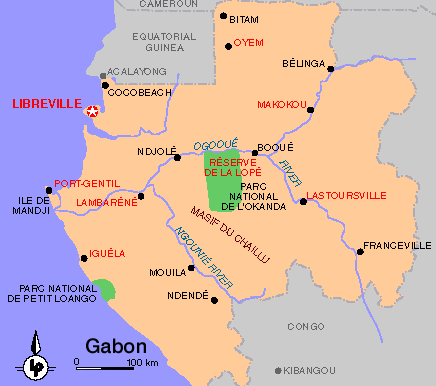 The
major stops are shown on this downloaded map. The capitol, Libreville,
is on the northwest coast. The Ogooué River runs through the heart
of Gabon; La Lopé Reserve is on its south bank in the center. Franceville
is down in the southeast, and Lekoni is southeast of Franceville. Makokou
is in the northeast with Bokaboka (not shown) well east of it, and Bélinga
(which is shown) to the northeast.
The
major stops are shown on this downloaded map. The capitol, Libreville,
is on the northwest coast. The Ogooué River runs through the heart
of Gabon; La Lopé Reserve is on its south bank in the center. Franceville
is down in the southeast, and Lekoni is southeast of Franceville. Makokou
is in the northeast with Bokaboka (not shown) well east of it, and Bélinga
(which is shown) to the northeast.
As we completed a grand loop around the country, four of our days were very long in the large van driven by Gastón, our personable Congolese driver. The roads were mostly rutted dirt heavily traveled by logging trucks, and would have been impassable mud in the rainy season. Our visit was in the dry season and we had essentially no rain. To reduce conflict, I always sat in the back of the bus where it was noisy and fishtailed the most, making it impossible to read or do anything but vegetate. The long drives were interminable as we drove through hours of great lowland forest.
We had Gastón for the long hauls, but when we switched to jeeps for the plains south of Franceville we had poor drivers who drove much too fast in marginal vehicles with bad tires. We were lucky there were no accidents on the winding paved roads; we had two flat tires out on the plains and required rescue by the Gabonese army. That wasted quite a bit of one day. At La Lopé, the men rode in the back of a pick-up truck while the two women rode in the cab. This got us to and from the forest just fine but was not conducive to birding. One just hung on for the ride. Nonetheless, we did see a good bit of Gabon in two weeks.
I ended up with 281 species on the trip, of which 179 were life birds. At least 27 more species were recorded by the leaders and/or rest of the group, so the tour total was a bit over 300 birds. There were very few waterbirds among them; indeed, only 26 species precede doves in the usual taxonomic order. A more detailed itinerary follows.
4 July 1996
We arrived yesterday night and stayed at Hotel Tropicana in Libreville,
Gabon's capitol. Saw a couple birds in the hotel garden and changed money
at a bank as soon as they opened. Unfortunately, our luggage did not arrive
with us in South Africa on 2 July, and so we have only the clothes on our
back. The airlines gave Rita & I a few bucks to get a toothbrush and
a T-shirt, and they promise to get the luggage to us tomorrow. Patrice
Christy has an agent in town who will pick it up and put it on a taxi to
La Lopé.
We left at 9:15 a.m. aboard our van for an all-day
drive to La Lopé. We arrived at 5:30 p.m. which is just about dusk
here on the Equator. We had brief stops enroute at the Bokoué River
bridge and lunch at N'djole. We stopped just short of La Lopé at
a logging yard with a view of the Ogooué River, and had a Red-chested
Swallow, only the third record for Gabon. I was not prepared for vagrants
the first day! It illustrates just how underbirded Gabon is; this swallow
may prove to be regular here.
La Lopé Lodge is very nice with individual
bungalows with private baths and pleasant beds. This was to turn out to
be the nicest place we stayed, by far. Below is our bungalow (left) and
our view of the Ogooué River from the porch (right).
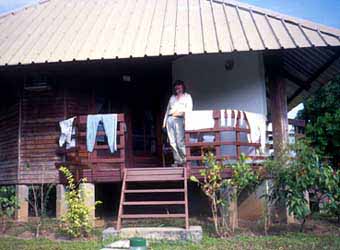
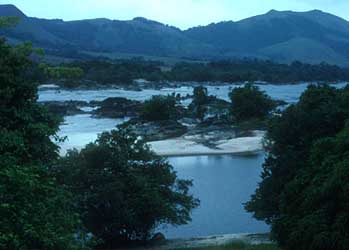
5-8 July 1996
Four days at La Lopé Reserve, a fabulous reserve full of birds
and mammals. It is said to have the highest populations of primates in
the world; we saw used night nests of Chimpanzee and heard some in the
distance. On 6 July a few of us had a thrilling experience with a Lowland
Gorilla (see the list for mammals for the story). We had Forest Elephant
and Forest Buffalo early and late in clearings. And the bird life was superb,
highlighted by seeing 6 of 7 possible hornbills, working out the greenbuls
and sunbirds, watching display flights of the recently discovered Dja River
Warbler. Some of us even had views of a displaying Lyre-tailed Honeyguide.
The four days were barely enough time to scratch the surface. Each highlight
took hours; it seemed like we worked on the displaying Honeyguide for a
whole morning, and the hike to the Dja River Warbler marsh took another
morning. The deep forest stroll that was punctuated by gorillas (!) was
a full morning. The photo (below right) is of Rita & Don deep
inside the forest, and not far from the gorilla spot.
 The reserve is primary rainforest along rivers interdigited within open
grasslands, so it was startling to drive from darkened forest interior
to sun-drenched hot savanna and back again on the Reserve roads. We spent
almost all the time on foot at forest edge, along the roads in the forest,
and (on 6 July) deep inside the forest on a path. Several local guides
were with us each day. Our group went back to the Lodge for lunch and a
nap at mid-day; I often spent this time alone along the Ogooué River
just below the lodge or in trying to take photos in the garden. There were
open grasslands and scrub around the Lodge, and we birded those habitats
late in the afternoon. A couple nights we went back to the Reserve for
night birds; Bates' Nightjar was the most impressive species found.
The reserve is primary rainforest along rivers interdigited within open
grasslands, so it was startling to drive from darkened forest interior
to sun-drenched hot savanna and back again on the Reserve roads. We spent
almost all the time on foot at forest edge, along the roads in the forest,
and (on 6 July) deep inside the forest on a path. Several local guides
were with us each day. Our group went back to the Lodge for lunch and a
nap at mid-day; I often spent this time alone along the Ogooué River
just below the lodge or in trying to take photos in the garden. There were
open grasslands and scrub around the Lodge, and we birded those habitats
late in the afternoon. A couple nights we went back to the Reserve for
night birds; Bates' Nightjar was the most impressive species found.
On our final day we came upon this huge undergrowth
flock on a thicketed hillside that Rita and I followed inside the undergrowth
and down the hill. We had an amazing variety of birds and good close views
of some skulkers that were largely missed by others on the tour (Yellow-bellied
Wattle-eye, Black-capped Illadopsis, Ansorge's Greenbul).
After a side trip to Zurich, our luggage arrived
safely by taxi the afternoon of 5 July. The food was good but service very
slow. Cold beer was available at night. I considered this a fabulous spot.
9 July 1996
Long nine-hour drive from La Lopé (7:30 a.m.) to Franceville
(5:30 p.m.) on generally rough dry-mud roads. Stopped at the Lolo River
crossing for swarms of swallows & swifts, and among them were a half-dozen
migrant African River Martins! We also had another stop for lunch at forest's
edge about halfway along.
We stayed at a reasonably modern hotel, the Intercontinental,
in Franceville. Right in the city the road by the hotel crossed a river
with power lines across it, and each evening huge swarms of Rosy Bee-eaters
roosted there.
10-11 July 1996
Two days on the Batéké Plateau, a 100 km drive south
of Franceville. This meant we were leaving at 5 a.m. after a 4:30 a.m.
breakfast in this huge empty hotel. We got back late as well, leaving us
exhausted and cranky.
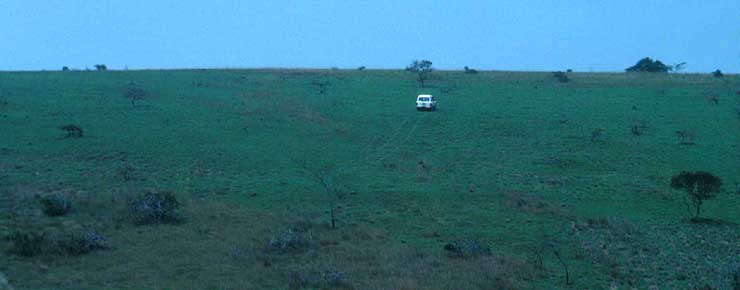

12 July 1996
Long drive through eastern Gabon from Franceville (left 6:30 a.m.)
to Makokou (arrive 3 p.m.). After reaching Makokou and checking into the
Ivindo Palace (a leaking dump of a hotel -- the worst on the trip -- but
with an amusing name), we went to the Limboumba River bridge outside of
Makokou where there was some nice forest at river's edge. We saw an otter,
and stayed until dusk when loudly calling Spot-breasted Ibises came to
roost.
13 July 1996
All day at M'Passa Reserve, mostly tracks & trails in primary forest
(7 a.m.-4:30 p.m.; lunch at the bus). M'Passa Reserve had been the site
of an active research center, and there are many published studies from
the Reserve cited in the Birds of Africa series. A network of trails
divide the forest into grids and it is easy to walk slowly through the
spectacular lowland jungle in any direction. Rita and I often went the
opposite direction of the tour group, missing their birds but finding many
on our own. The forest is full of birds. Canopy flocks need to be scanned
with a scope from the main trail but they can be very rewarding. The display
flights of Rufous-sided Broadbill are heard daily, although it takes quite
an effort to track one down.
There is a central clearing surrounded by research
buildings. Alas, the project has been abandoned. The buildings are rotting
away as the forest encroaches. Looking through the windows one sees blackboards,
desks, microscropes -- it looks like the researchers just got up and left
without taking anything with them. The monkeys are more afraid of humans
here than at La Lopé, possibly because there is some poaching on
the reserve. Thus while it is a fabulous research area it is not as pristine
as La Lopé.
In addition, the entrance road into the reserve
goes through a variety of scrub and plantation habitats with other sets
of species, and Ian & Patrice knew very well where specialized greenbuls
might be located. We worked these locations early and late.
14 July 1996
 This
was rockfowl day! Three hour drive east of Makokou (5-8 a.m.) to Bokaboka,
then 2.5 hour hike to the cave (perhaps 4-5 miles from town?) through swamp
forest, primary rain forest, and up a steep hill to the Picathartes cave.
"We tour participants perched on overlook whilst Ian & Patrice walked
to top of the cave complex, forcing two rockfowl to hurtle out the lower
left corner and right at us. We got only a few seconds look, but it was
clear and unrestricted. They are almost as large as a Greater Roadrunner
(..none around to compare... duh) and had long neck & long tail." Pictured
(right) is Patrice Christy standing at our overlook spot with the
cave mouth up and to the left of him. [See my Rockfowl
page for more photos and details.]
This
was rockfowl day! Three hour drive east of Makokou (5-8 a.m.) to Bokaboka,
then 2.5 hour hike to the cave (perhaps 4-5 miles from town?) through swamp
forest, primary rain forest, and up a steep hill to the Picathartes cave.
"We tour participants perched on overlook whilst Ian & Patrice walked
to top of the cave complex, forcing two rockfowl to hurtle out the lower
left corner and right at us. We got only a few seconds look, but it was
clear and unrestricted. They are almost as large as a Greater Roadrunner
(..none around to compare... duh) and had long neck & long tail." Pictured
(right) is Patrice Christy standing at our overlook spot with the
cave mouth up and to the left of him. [See my Rockfowl
page for more photos and details.]
We then waited for an hour, hiding behind rocks,
in hopes the rockfowl would return, but they did not. Because of the distance
and the group, we didn't really bird much enroute either way. But in the
morning hike we did see a Yellow-throated Cuckoo nicely that Ian &
Patrice may have considered the best bird of the trip.
One passes through several Army roadblocks enroute
to and from Bokaboka where papers and permits must be shown. At one such
stop we could hear an official lecturing (in French) all the village residents
about the dangers of eating gorilla and chimpanzee meat. There had been
an Ebola outbreak near here fairly recently, apparently traced to villagers
eating a sick chimpanzee they had found and killed.
15 July 1996
In an early morning walk around Ivindo Palace Hotel in Makokou, we
found & photographed a roosting Fraser's Eagle-Owl. The rest of the
day at M'Passa Reserve, mostly inside the forest, and half the time alone
with Rita slowly walking the trails.
16 July 1996
Drove two hours (6:30-8:30 a.m.) to Bélinga Road, 40 km east
of Makokou; this is a fine road through primary rain forest (below).
The road is no longer used as a bridge is out, so there was no traffic.
We simply walked portions all day with a midday rest at the river where
the bridge is out. Spent a fair bit of time trying to see a calling Bare-cheeked
Trogon with limited success. In late afternoon we came upon a feeding frenzy
in the canopy. There, among a tree full of yellow flowers, was a termite
hatch and birds were going crazy, especially a fly-catching African Pied
Hornbill. Among others in the flock were Black-throated Malimbes, a Blue-throated
Roller, Yellow-mantled Weaver, and Velvet-mantled Drongos.

17 July 1996
Up very early for an all-day drive from Makokou back to Libreville
(5 a.m. to 4 p.m.). Initial plans to fly had fallen through. Brief stop
for lunch only at a spot that had a pair of Forest Swallows. A few birds
seen around Libreville.
18 July 1996
A few more birds in the Hotel Tropicana garden, and then to the airport
for a mid-day flight to Saô Tome.
|
covering both birds & mammals |
PHOTOS: All photos on this page are © 1981, 2001 Don Roberson, except those attributed to Rita Carratello who holds those copyrights; all rights reserved. Other shots from this trip are scattered about the web site. Check particularly bird families and mammals listings.
Literature cited:
Christy, P., and W. Clarke. 1994. Guide des Oiseaux de la Réserve de la Lopé. Ecofac Gabon, Libreville.TOPKeith, S., E. K. Urban, and C. H. Fry. 1992. The Birds of Africa. Vol. 4. Academic Press, London.
Mackworth-Praed, C. W., and C. H. S. Grant. 1970-1973. African Handbook of Birds. Series III. Birds of West Central and Western Africa. Vol. 1 and 2. Longmans, Edinburgh.
Sargeant, D. 1993. A Birders Guide to Gabon, West Africa. Privately published by D. E. Sargeant.
Serle, W., and G. J. Morel. 1977. A Field Guide to the Birds of West Africa. Collins, London.
Sinclair, I., P. Hockey, and W. Tarboton. 1993. Illustrated Guide to the Birds of Southern Africa. New Holland, London.
GO TO LIST OF BIRD FAMILIES OF THE WORLD